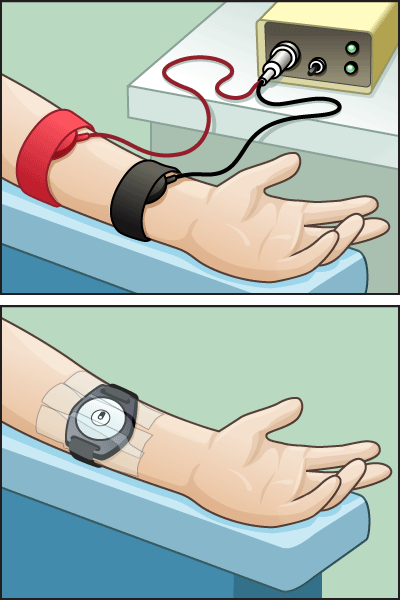Cystic Fibrosis (CF) Chloride Sweat Test
What It Is
A chloride sweat test helps diagnose cystic fibrosis (CF), an inherited disorder that makes kids sick by disrupting the normal function of epithelial cells. These cells make up the sweat glands in the skin and also line passageways inside the lungs, liver, pancreas, and digestive and reproductive systems. Kids who have CF are at risk for repeated lung infections.
The sweat test measures the amount of chloride in sweat. Kids with cystic fibrosis can have two to five times the normal amount of chloride in their sweat. In a sweat test, the skin is stimulated to produce enough sweat to be absorbed into a special collector and then analyzed.
Doctors may test an infant suspected of having cystic fibrosis as early as 48 hours after birth, though any test done during a baby's first month might need to be repeated because newborns may not produce enough sweat to ensure reliable results.
Why It's Done
Doctors will order a chloride sweat test for kids with positive newborn screen for cystic fibrosis, a family history of cystic fibrosis, or symptoms of the disorder. Symptoms and signs include failure to grow, repeated lung infections, and digestive problems.
Preparation
No special preparation is necessary for this test. Before having this test, your child may eat, drink, and exercise as usual, and continue to take any current medicines. Creams and lotions should not be applied to the skin 24 hours before the procedure. A sweat test usually takes about an hour, so you may want to bring books or toys to help your child pass the time.
There are no needles used in this procedure.
Page 1
The Procedure
An area of skin on the arm will be washed and dried. Next, two electrodes are attached with straps. One of these contains a disc with pilocarpine gel, a medicine that makes the sweat glands produce sweat. A weak electric current pushes the medicine through the skin. After this is done, the electrodes are removed and the skin is cleansed.

A special sweat collection device is then attached to the clean skin surface in the area where the sweat glands were stimulated. It's taped to the skin to keep it from moving. The sweat is collected for 30 minutes. The sweat that's collected turns blue when it comes into contact with blue dye within the collector, making it visible to the technician.
After enough sweat is in the tubing inside the collector, it's removed and placed in the sweat analyzer. The collector is removed and the arm is cleaned again. Your child's skin may remain red and continue sweating for several hours after the test.
Page 2
What to Expect
This test shouldn't be painful, though some kids do feel a slight tingling or tickling sensation when the electrodes apply current to the skin.
Getting the Results
Results are usually available in 1–2 days.
If your child has a sweat chloride level of more than 60 millimoles per liter, it's considered abnormal and indicates a high likelihood of cystic fibrosis, though some children with CF do have borderline or even normal sweat chloride levels. If more sweat is needed, the test might be repeated. If results are positive or unclear, a blood test may be done, especially for babies.
Risks
This test poses very little risk of complications. The electrical current may cause your child's skin to be red or to sweat excessively for a short period of time. In rare cases, the skin may look slightly sunburned.
Helping Your Child
You may choose to stay with your child to help keep him or her distracted during the test.
If You Have Questions
If you have questions about the chloride sweat test and how it's conducted, speak with your doctor.
